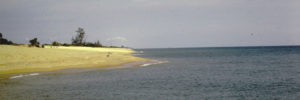
A recent (and eagerly anticipated) visit to Hawaii has me thinking about sea turtles again. What an ancient group they are. For over 100 million years they have steadfastly rowed their way across the world’s oceans. This is a small taxonomic group with only a few living species and in our short time at the helm, we humans have managed to endanger most of them. My hopes for these fascinating animals were somewhat lifted while snorkeling in Hawaii where I saw more green turtles than I had ever before encountered. Cruising along the surface while relishing sightings of butterfly fish, Moorish idols, parrot fish, tangs and trigger fish I would find myself startled as a large honu suddenly loomed into my peripheral vision. There seemed to be a mutual curiosity between these hefty turtles (100 – 400 lbs.) and myself. What manner of creature now shared their waters they appeared to ponder? Satisfying their inquisitiveness, they would slowly swim away seemingly intent upon discovering what algae was on today’s menu. These chance meetings with green turtles were certainly delightful but they stirred memories of even more unforgettable encounters with sea turtles. To describe these, I must go back many years and speak of another species entirely.
In 1973 the east coast of peninsular Malaysia was pristine. From the state of Johore in the south to Kelantan in the north, there stretched over three hundred miles of undeveloped beach. Composed of golden, wheat-colored sand, the palm-lined coast was steadily caressed by the gentle surf of the South China Sea. To me it seemed a veritable paradise. As a biologist, one special part of that vast unspoiled beach made it seem particularly blissful. At a place called Rantau Abang, the leatherback sea turtle (Dermochelys coriacea) came ashore to nest. I describe the turtle’s behavior as “to nest” but this is a pitiful, inadequate idiom. It is an admittedly unsatisfactory, incomplete catchphrase to use when attempting to describe one of the natural world’s most fascinating wildlife pageants.
Alas, in my sharing of this unique biological story, I must also grieve. For what I am about to describe for you is an account of a paradise that is lost. Now, should I desire to again experience the deep-seated instinct for nurturing and the expression of ancient rhythms which characterize the nesting of the leatherback sea turtles, I too must rely solely on the conjuring powers of the mind. By means of the enigmatic neural capacity we call memory I cling to the reminiscences of this primeval biological ritual as I would some irreplaceable treasure. Sadly, the spectacle of the leatherbacks nesting upon those golden sands is no more.
This is how I came to know a little of Dermochelys coriacea. In 1973, I had found myself newly removed from the temperate realm of Indiana and entrenched in the tropical environs of Malaysia. As a field biologist, the chance to experience Malaysia was the fulfillment of a dream. Here was a country not much larger (excluding the Bornean states of Sabah and Sarawak) than my Hoosier home. However this comparable geographic area harbored five times as many plant species, thrice the number of bird and mammal species, and six times the number of amphibian and reptiles as did my home state. What biologist would not be thrilled to work in such an environment?
Soon after arriving, a Malaysian colleague suggested that I should make a trip to the east coast. They guaranteed that I would find the sea turtle nesting area there to be of great interest. And so come June, wife Anne, daughter Michelle, and I piled into our diminutive Mitsubishi Colt and headed northeast toward the city of Kuantan. We soon found ourselves climbing into the low mountains which run down the Malay Peninsula’s middle. The slopes were covered by lowland tropical rainforest in many places. In others, the forest had been cleared and in these deforested areas we passed Malay kampongs, rubber plantations, and large tracts of oil palm plantings. From Kuantan, the capital of the state of Pahang, we motored north along the beautiful, mostly deserted coast into Terengganu state. Some 20 km. north of the town of Kuala Dungun, we arrived at a small collection of houses and food stalls – Rantau Abang.
Unsure at to the procedure involved in turtle watching, we made inquiries with the villagers and were directed to one of two small cottages that were available. These were rented to visitors wanting to see the leatherbacks come ashore. We booked one of these and transferred our few possessions inside. The house, if I may call it that, was tiny with dimensions of about 12 ft. X 12 ft. There was no bathroom or running water. In fact, the only furnishing was a large bed which occupied most of the cabin. This was a logical arrangement as one had to stay up most of the night in order to see the turtles. Most of the day was to be spent sleeping. Leatherback sea turtle watching was a third shift job.
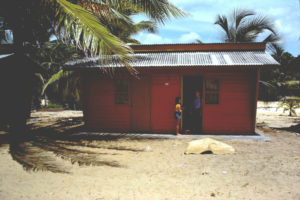
Bathing was accomplished at an outside faucet near the cottage. Even for the three of us, who had experienced the whole gamut of intriguing third-world toilet possibilities, using the outside latrine was a frightening procedure. It was an outhouse of course built in the pit latrine style. This in itself wasn’t a particular bother. It was the covering of the toilet pit that prompted divinations of a potentially ghastly accident. Over the pit was arranged a mat of loosely assembled saplings two or three inches in diameter. I suppose, by loose definition, this covering could have been called a floor. But stepping upon this, as you can imagine, was akin to the feeling one might experience by walking on a trampoline. It really was quite terrifying to imagine these saplings suddenly giving way and allowing one to plunge into the sewage laden abyss just below. There was no proper toilet seat of course. Here the Asian custom of simply squatting was to be used. The floor always held, but every trip to the privy was a terror-ridden experiment.
One might think that, rather than sleep the day away in bed, a few hours at the beach would be time better spent. If you were to express this notion, then I would conclude that you had never been to the lowlands of a country located near the equator. Here the sun is so intense that lounging about on the beach at midday is simply out of the question. During the day, the sand was so hot that it was virtually impossible to walk upon it barefooted. It would have been akin to walking barefoot across an asphalt parking lot at midday. So it was that we napped, lounged about, read, visited the local kedais for lunches of fried rice, and otherwise whiled away the time until we could make the much anticipated visit to the beach at night.
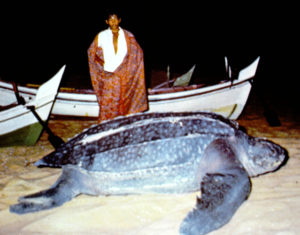
Naturally, the female turtles had to come ashore at night in order to lay their eggs. Not having the ability to precisely temperature regulate as do mammals, long term exposure to the sun could be lethal. Male leatherback sea turtles do not come ashore again once they leave the nest and rush down into the ocean. They spend this nesting time patrolling off the beach, out to sea, engaging in the two most basic survival behaviors of the animal kingdom – eating and mating.
In Malaysia, as is typical at the equator, there are roughly twelve hours of daylight and twelve hours of darkness. As sunset approached, we went for a late swim and then a leisurely dinner of rice and delicious curries of fish or chicken. As the evening grew ever darker, we tested our lights and at 10:30PM set off down the beach. It was wonderful to walk the shoreline at night. With the blazing sun now gone for a few hours, the temperature had fallen to a pleasant 75F. A moderate breeze flowed from the water bringing the rich, organic smell that even from a distance tells one that the sea is near. It is I suppose the odor of saltwater and fish, crab and clam, worm and whale all mixed into a delightful aromatic stew that speaks as clearly as if vocalized – here is life, abundant and rich.
Given the inky darkness, we wondered how difficult it might be to find a single female turtle far up on the beach. We needn’t have worried. Very soon we stumbled upon what one might have mistaken for the tracks of some giant piece of construction equipment. Emerging from the ocean and climbing up the beach, the deep symmetrical markings in the sand ascended up beyond the tide line. The form of the trail was a broad central, flattened drag mark about two feet wide. This was where the lower shell or plastron had dragged the sand. On each side of this were deep comma-shaped depressions in the sand a few feet in length. These marked the spots where the female leatherback’s forelimbs had dug into the sand as she thrust herself forward. The trenches were regularly spaced about a foot apart and lured us up the beach. We turned and followed them landward.
Playing our torches (we Americans call them flashlights) over the sand ahead of us, we soon could see the huge, dark form of the leatherback up ahead. I do not use the term huge lightly. Back home in Indiana, the largest turtle I had ever seen was a hefty common snapping turtle that weighed maybe thirty pounds. Now, lying before us upon the sand was a sea turtle that weighed in at over six hundred pounds. Her size was simply astounding. Leatherbacks may reach a length of over six feet, grow to well over one thousand pounds, and have a front flipper span of eight feet. They are the largest living turtle species in the world. Examining her more closely, the unique design of her carapace was revealed. The most distinctive feature of this dorsal shell was how dissimilar it was to any turtle I had seen before. Instead of a surface comprised of large adjoining scales, the back was a smooth almost blackish color. Rather than the hard, bone-like feel imparted by a typical turtle, the leatherback’s carapace appeared to be made of dense rubber. The “shell’s” texture and density looked very much like that of a hockey puck or the rubber tread of a heavy truck tire. The carapace was marked with scattered light blotches and several longitudinal ridges ran its length. Suspended from the old female’s eyes were large, mucus-like blobs which looked very much like enormous, thick tears. These kept her eyes from drying while she was out of the water. The tears also helped wash away any sand accidentally flipped into her eyes as she ascended the beach. To me, with the human tendency to anthropomorphize, the tears looked like visible emblems of the struggle she was facing in pulling her enormous mass up the beach. Without the buoying effect of the water and with her adaptations for life in the sea, the trip onto land was a taxing one.
Fortunately, we had found this female just in time. As we stood admiring her remarkable beauty of form she began to dig. Using her paddle-like hind flippers much as we would use our hands, she removed scoop after scoop of sand. After about fifteen minutes of digging the nest cavity was complete. It was a vertical hole in the sand perhaps a foot in diameter and three feet deep. The hole looked remarkably as though someone had dug it with a set of posthole diggers. It appeared perfectly round in cross-section and equally faultless in the smoothness of the walls and their verticality. Now she began to lay. One after another her large spherical eggs, about the size of snooker balls, dropped into the hole in the sand. The eggs weren’t broken by this fall because a reptile egg shell is not hard, brittle, or fragile like that of a bird. Rather the shell of reptile eggs is flexible and feels rather like thick
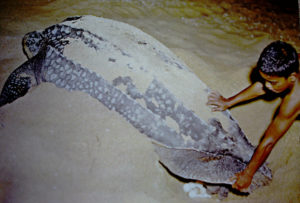
parchment paper. Thus the fall to the lowermost end of the nest chamber resulted not in a cracking sound but an audible, deep thud when an egg reached bottom. Watching several females nest over a period of days, we found the typical number of eggs laid ranged from fifty-five to sixty.
Having completed her laying, the turtle now began to fill the nest with sand. Again using quite hand-like movements of her pelvic flippers, she picked up portions of sand and placed them back into the nest hole. Periodically, she tamped these with her hind limbs to pack the sand. Having filled the nest hole, one might suppose that the mother would return directly to the water. This was not so. There were predators on the beach and they needed to be thwarted. In this part of the world, a chief threat came from large monitor lizards. They relished nothing more than discovering a leatherback nest and devouring all the eggs. In different parts of the world, sea turtle nests are attacked by a variety of other animals including raccoons, coatis, and dogs.

Because of the danger of predators the female turtle began her set routine of nest-hiding behavior. She worked onward with unwavering instinct. Dragging herself a few feet from the nest, she paused and began to make large, violent backward sweeps with her flippers. The sand was thrown rearward with terrific force over the site of the nest hole. Standing in the path of the flying sand, one felt as though a sand-blasting machine was being directed at one’s legs. After several strokes the female would crawl to a different side of the nest and repeat the sand throwing performance. This behavior was repeated another time or two and, when she had finished, the nest site was obliterated. It was as though one had taken a huge broom and thoroughly swept the area. No sign of the nest by which a predator might locate its precious contents remained. Having completed her work, the female now retraced her path to the sea. With ponderous movements of the flippers, she hoisted the front of her body off the sand and dragged herself down the sloping beach and into the surf. Most of the females repeated this trek onto the nesting beach and back to the sea several times during the nesting season.
Of course there was one predator who was not deterred by the leatherback’s elaborate nest hiding activities. The greatest threat of all to these sea turtle nests was human. Knowing when and to where the turtles would return, people were waiting. Finding an ovulating turtle, they simply confiscated each egg as it was laid. We found it terribly dismaying to watch a local villager methodically take every egg being produced by an ancient matriarch and drop it into their bucket. Here were half a hundred leatherbacks that would never taste the brine of the South China Sea. Neither was it difficult to imagine the impact on the species resulting from a large number of villagers plundering nests in this manner. Knowing that a nest was thus emptied, we would occasionally watch in deep anguish as a female turtle spent a half hour methodically hiding eggs which no longer existed.
For those eggs that did remain untouched, a period of development was now entered upon. It would be nearly two months before the young turtles were to emerge. The temperature at which the leatherback eggs develop is quite critical. Nest temperatures in the mid-eighties produce a mix of both male and female young. Higher temperatures result in the development of females while lower temperatures lead to the production of males. Incidentally, scientists today are reporting certain sea turtle populations which are highly skewed toward females. Global warming with its attendant increase in beach sand temperature is the suspected culprit; yet another threat to these already endangered animals.
At Rantau Abang, in the 1970’s, there was a government run hatchery of a
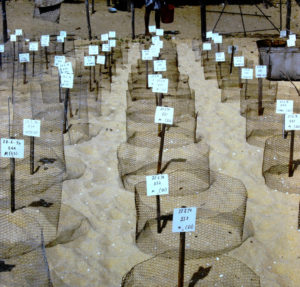
primitive sort. It consisted of a fenced-in area of about four thousand square feet. There was a small hut for storage and shade used by the old Malay fellow who tended the nursery. Within the enclosure we saw row after row of hardware cloth cylinders protruding from the sand. Each one contained the eggs taken from a turtle nest on a designated stretch of the beach. Outside this chosen area, turtle eggs were fair game and the locals consumed most of them. Each nest was marked by an identification number, the date the eggs were laid, and the number of eggs buried there. It was quite delightful to arrive at the hatchery early in the morning and see the dozens of little, three inch long leatherbacks which had hatched during the wee hours. They scrambled over one another and charged the walls of their enclosure in a frantic, instinctive attempt to reach the sea. Soon the old attendant would arrive with his red plastic bucket. Placing the agitated baby turtles in this, he would plod down to the edge of the surf and drop them into the water. They looked far too tiny to be venturing off on their own into the world’s largest ocean. It was better not to imagine the menagerie of enemies they faced out there. With sea birds, sharks, and large voracious fish on the lookout for an easy meal, the future of the baby turtles was rife with hazards. In fact, it is estimated that only about one in a thousand of these little hatchlings ever returns to its place of birth, one tenth of one percent; not very good survival odds. For those that do endure, a great migration was in store. Leaving the shores of Malaysia, the turtles would strike out for the far reaches of the eastern Pacific. Ranging far out into the open ocean before they turned westward once again, these leatherbacks would swim thousands of miles before yet again reaching these tropical shores.
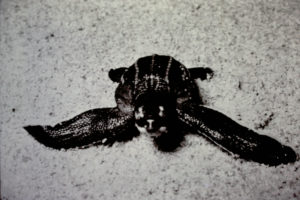
Anne, Michelle, and I came away from Rantau Abang feeling privileged by our opportunity to have witnessed one of the earth’s greatest wildlife spectacles. We also carried away with us a gnawing dread that the leatherback’s future was uncertain. We hoped, perhaps even believed, in the optimistic manner of youth that more government protection of the turtles would soon be forthcoming. A mile of protected beach upon this vast coast was an absurdity. Surely the eating of the turtle’s eggs by villagers would be seen as unsustainable. We thought the residents themselves would most certainly realize that the nesting of the turtles produced, for them, the golden eggs of tourism. No turtles. No tourists. No tourists. No money. It all seemed so simple. But, as I said, we were young and unwise. We had underestimated the depths to which human greediness and thoughtlessness can progress.
Nearly all the world’s sea turtle species are now considered endangered. It pains me to think of the vast geologic history of these animals and their now perilous status among earth’s fauna. Here we have a group of animals whose ancestors swam with the plesiosaurs and nested on beaches trod upon by the dinosaurs. For over a hundred million years they withstood the ravages of climate change, predators, disease, and ocean hazard. Now, in just a few decades, these amazing reptiles find their kind decimated by the carelessness, avarice, and callousness of the human species. We have eaten their eggs and flesh. We have ground their bone into fertilizer. We have converted their skin and shells into trinkets. Their nesting beaches have been appropriated by condominiums and high-rise apartments. Our light pollution, glaring upon roadways and parking lots, is mistaken for starlight on water and lures hatchlings to their deaths. Many sea turtles are entrapped and drowned in fishing nets. For leatherbacks, plastic bags floating in the water look just like their favorite food – jellyfishes. They cannot digest plastic. It often seems to me that we are Hell-bent on destroying an entire subgroup of reptiles with nary a regretful look back.
I have not been back to Rantau Abang in nearly forty years. During all this time, I have found myself periodically dreaming of a return to those beautiful tropical shores. I imagined that perhaps my grandchildren might accompany me. What a wondrous thing it would be, I daydreamed, to gaze upon their awestricken faces as they stood next to a nesting female ten times their size. But I now know that this will not happen. As I told you, this is a story of paradise lost. In the 1950’s, ten thousand leatherbacks nested on the east coast of Malaysia. Six thousand nests were reported in the early 1970’s when we were there. By the year 2000, less than ten nests were completed at Rantau Abang. In two decades the number of nesting turtles declined by 90%. Recently, in verification of my ominous premonitions, I read a commentary announcing that researchers now believe populations of the Pacific leatherback sea turtle may be lost in the next two decades. Malaysian populations, the article declared, are already extinct. And now, so are my dreams.
A Postscript:
The New Straits Times (an English-language newspaper published in Malaysia) in an article dated September 11, 2017 announced that, for the first time since 2010, a leatherback sea turtle had returned to nest at Rantau Abang. It was the first nesting in seven years. Does a thin thread of hope still exist or are we simply hearing the last whimpers of a dying species?
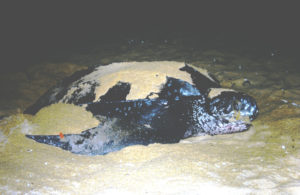

Another great read. Thank you for sharing and educating.
Thanks Lanier. Really appreciate your following (and encouragement).